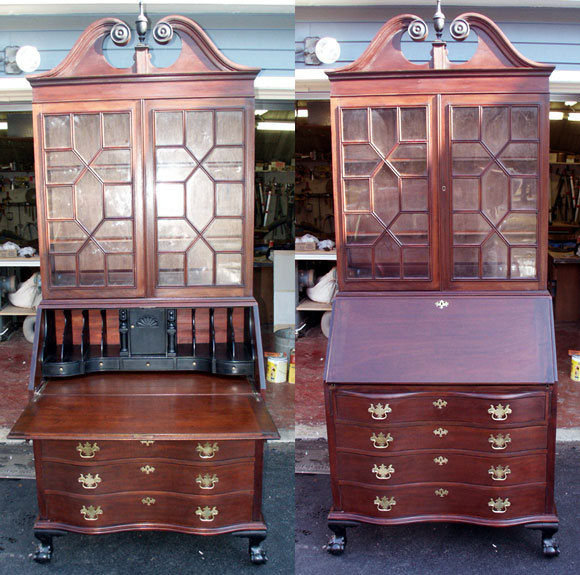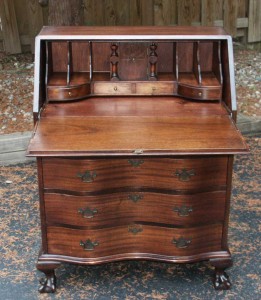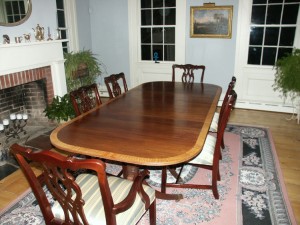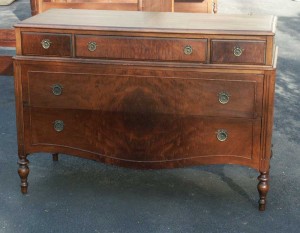Furniture Restoration in the 21st Century – Circa 1920-1940 Comes of Age
By Eric Saperstein on Aug 21, 2009 in Furniture Restoration
Article By Stanley D. Saperstein
Artisans of the Valley
Master Craftsman, Emeritus
As we complete the first decade of the of the 21 first Century we at Artisans of the Valley has noticed a new trend in the collectible and Antique markets which challenges the established definition of furniture values. When I founded Artisans back in 1973, our shop received a flow of real antique furniture which by definition is prior to 1840 the age of handmade furniture. Secondary restorations were request on post 1840 or machine age furniture, a period when the fine pegged mortise and tenon joints and dovetail joints were replaced by screws.
By the 1980’s Victorian furniture began to take the front row, followed by Golden Oak and mission style furniture. These pieces generated the bulk of our restoration business until the end of the 20th century, when suddenly and all of a sudden entire estates of furniture from the twenties thirties and forties came in.
On vacation we always stop in antique shops, exploring local markets, and discussing our trade with other craftsmen. We soon discovered that what they called antiques, or more correctly collectibles, was the same furniture my parents had. This type of furniture was being inherited by the grandchildren in mass, and a new generation was discovering that compared to the press board fake, plastic wood surfaces stapled together the furniture common in furniture stores today these heirlooms were far superior.
Many of these pieces are well built, good construction using fine quality old growth hardwoods woods, thick veneers, and dovetailed drawers. When they arrive at our shop, the finish on almost every one is completely deteriorated, and the pieces often are loose at almost every joint. Loose joints are not always apparent until after the pieces are relocated, the vibration of the moving truck and the torsion of lifting shatters the crystallized glue leaving the shrunken joints to separate or rotate on a single nail or peg.
What’s amazing about this situation is that they are ready made and prepped for restoration in this state. The furniture can be easily disassembled, broken down into substructures and often individual pieces. Once apart, the piece can be completely cleaned, reassembled, and refinished to sustain functional service for many generations to come.
Unlike real antiques were major repairs and new finishes diminish the value and history of some pieces, collectible furniture always increases in value when a proper restoration is complete. The value of a piece in poor condition, often falling apart is perhaps a few hundred dollars, once restored the minimum value is the restoration cost, in many cases even double the investment made to restore them.
For example a typical, basic, 1930’s dining room set with a table, server, curio, and six chairs pre-restoration can be bought in the $1,500-$3,000 range. Found in estate sales, consignment shops, local antique stores, online, or even at yard sales.
Restoration, as an example may run $3,000-$4,000, the finished set will now hold its value in the $4,500-$7,000 range, for a good find of a high quality set the restored value can actual generate a potential return on your investment. To purchase a comparable set made by a top company like Kittinger new would run easily $15,000 – $30,000. A commission for a hand made set can often double that estimate.
The moral of this being – the restoration of collectible furniture, especially that received as an heirloom, is cost effective, environmentally responsible, and results in a quality, functional, and beautiful edition to your decor.
When Artisans gets a piece of this type of furniture into our shop a complete refinish and rebuild is the most common plan. We remove that old dense colored lacquer, a finish that masks the real beauty of the wood, and refinish using a fine Waterlox tung oil varnish for the finish with the clients choice of stain. If necessary the piece is disassembled and re-glued with modern adhesive, this reinforces all the joints with a compound that is far superior to the old hide glue.
On completion, the clients get a beautifully renewed, structurally sound piece of furniture that if properly maintained will be passed to their children or grandchildren.
Check our web site Conservation Services and Restoration Gallery and you will see what I am talking about.
Visit our website at www.artisansofthevalley.com





Sorry, comments for this entry are closed at this time.